Once one of the most controversial aircraft to grace the sky, the last operational variant of the first variable-geometry warplane went out of business back at the start of this month, with the very last flying example being cut up to be shipped to a museum.
The Royal Australian Air Force (RAAF) has bid a final farewell to its last remaining F-111, which is being taken from Amberley base, west of Brisbane, to Hawaii.
The much-loved fighter bomber had its wings clipped ahead of its last journey to the Pacific Air Museum at Pearl Harbour.
Wing Commander Clive Wells has managed the disposal of all the Air Force’s F-111s.
“It’s quite an historic day from an Air Force perspective particularly for the guys who’ve worked on the F-111 … to see the last one just about to depart,” he said.
The RAAF originally purchased 43 F-111s.
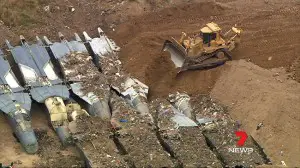
Fate of most Australian F-111s. Due to asbestos content, only a few were given to museums, and only on-base museums. The rest of the fleet? Wings and engines were sold for scrap, the fuselages buried.
Eight crashed, 23 were buried, and the remainder have been put on display in defence establishments and museums around Australia.
The F-111 was the plane which flew for the halting and jerky development of the precision-guided-weapon tactics that would win the initial phase of the US Afghan war. While its own night and all-weather bombing equipment was state of the art in the 1960s, by the 1980s F-11F crews, and their Australian F-111C and later -G counterparts, were working on beacon bombing and hitting targets marked with ground laser designators.
There was nothing quite like having an Aardvark go over your head at Mach .9+ and nought feet, on its way to pickle on your beacon or GLD paint. Its mighty turbofans shook the earth, and as it came off the target in burner it left streaks in the sky — these missions always took place at night. With relatively crude Paveway laser-guided bombs, and dumb bombs dropped on a beacon offset, the F-111 was a vital long-range, precision-strike weapon. The Australians one-upped the plane’s American inventors with a flaming fuel-dump display at airshows.
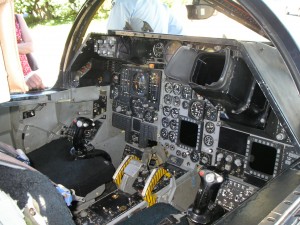
The office — state of the art, circa President Kennedy. (This is an RAAF plane, photographed circa 1978). Pilot sits left, WSO/Navigator right.
The F-111 had a troubled gestation, forced down the services’ throats by Robert S. Macnamara. The General Dynamics (ex-Convair) version of the design flunked every competitive evaluation against a Boeing competitor, but was selected, reportedly because Macnamara wanted to curry favor with LBJ: the President and General Dynamics were both Texans, after all. The jets’ first combat rotation in Vietnam ended in ignominious withdrawal after two ships lawn-darted fatally due to a terrain-following-system glitch. The jets went through several different intake designs, each one solving some old problems and introducing new ones. But in time, the plane became a reasonably successful combat ship, particularly in the 1986 strike on Libya (Operation El Dorado Canyon, see also Walter Boyne in Air Force Magazine) and in Desert Storm.
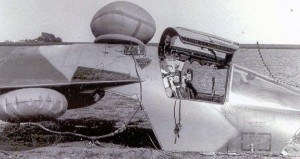
One of the plane’s Rube Goldberg features was its Escape Module — the entire cockpit was capable of blasting off and saving the crew.
Australia is in a bit of a jam without the ‘Varks, as they had a 3500-mile range on internal fuel. It’s somewhat academic, perhaps: unlike the well-blooded American ‘Varks, the antipodean ones never saw combat. The RAAF is going to develop aerial tanking capability to get a sort of feeble simulacrum of the lost 111 capability with its sole remaining combat type, the F-18 Hornet. The Hornets are scheduled to be replaced with F-35 Lightnings, but the Australians are watching the F-35’s spiraling cost with dismay. Neither the Hornets nor the Lightnings can match the 111 for range and armament payload; but the 1960s-vintage jets were too costly to maintain.

Kevin was a former Special Forces weapons man (MOS 18B, before the 18 series, 11B with Skill Qualification Indicator of S). His focus was on weapons: their history, effects and employment. He started WeaponsMan.com in 2011 and operated it until he passed away in 2017. His work is being preserved here at the request of his family.

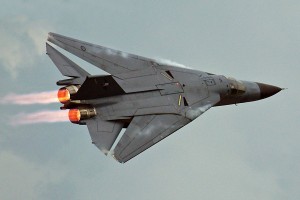
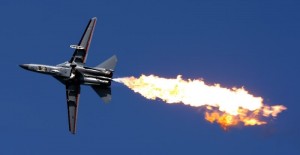
7 thoughts on “End of the Line: F-111 Aardvark/Pig”
Wotan, the asbestos paranoia seems extremely idiotic…
If something made out of asbestos is painted, or encased somewhere, so it’s not letting loose fibers into the air, it’s not dangerous..
Shhhh! No science when environmentalists are tripping over the Precautionary Principle.
I give them a few years before they realize they have planted these malefic fibers under the fair skin of Mother Gaia… high adventure and low comedy will predictably follow.
No F-111s flew in Afghanistan. The last USAF versions were retired in 1998 and Australia deployed no F-111 to Afghanistan.
We didn’t say that, Alan. We said the tactics we proved out with the ‘Vark won the war. In 10/01-12/01, these tactics ran with the SF and other government agency personnel on the ground, and the USAF (mostly) in the air, the most effective of which were F-15E Strike Eagles and strategic bombers with JDAMs. Improvement in the PGM and all-weather capability of other platforms made them more effective than the 111, but nothing comes close to its range and loiter time unless you go to a strategic bomber.
The F-111s only combat theaters were Vietnam, a single strike on Libya, and Desert Storm. I believe F-111Fs made a demonstration run during Earnest Will/Prime Chance but did not drop. That was mostly a Naval Air and rotary-wing rodeo.
I know it’s irrational, but the bulldozer pic made me feel a little ill. 🙁
Despite being another one of McNamara’s gee-whiz bastard stepchildren, I always kinda liked them.
(Never should have gotten within a country mile of a carrier flight deck, but once McTarded was a memory, they went away never to return.)
Having a few of them go by with the throttles on loud, both out on desert field trips, and at a couple of airshows, cemented my assessments. Much like the B-58, it’s fortunate that little use was made of them, but they were a plane that deserved to be made and flown in their day, and in the air, they look like the raptors they were intended to be.
And I have to agree: shovelling them under is just wrong. At the worst, they should be quietly basking in the sunshine of a windswept Arizona boneyard, if not perched on concrete pads at the base front gates of a select few facilities.